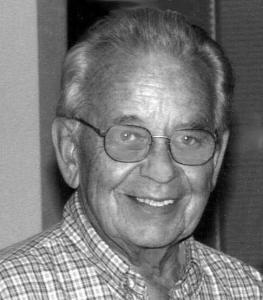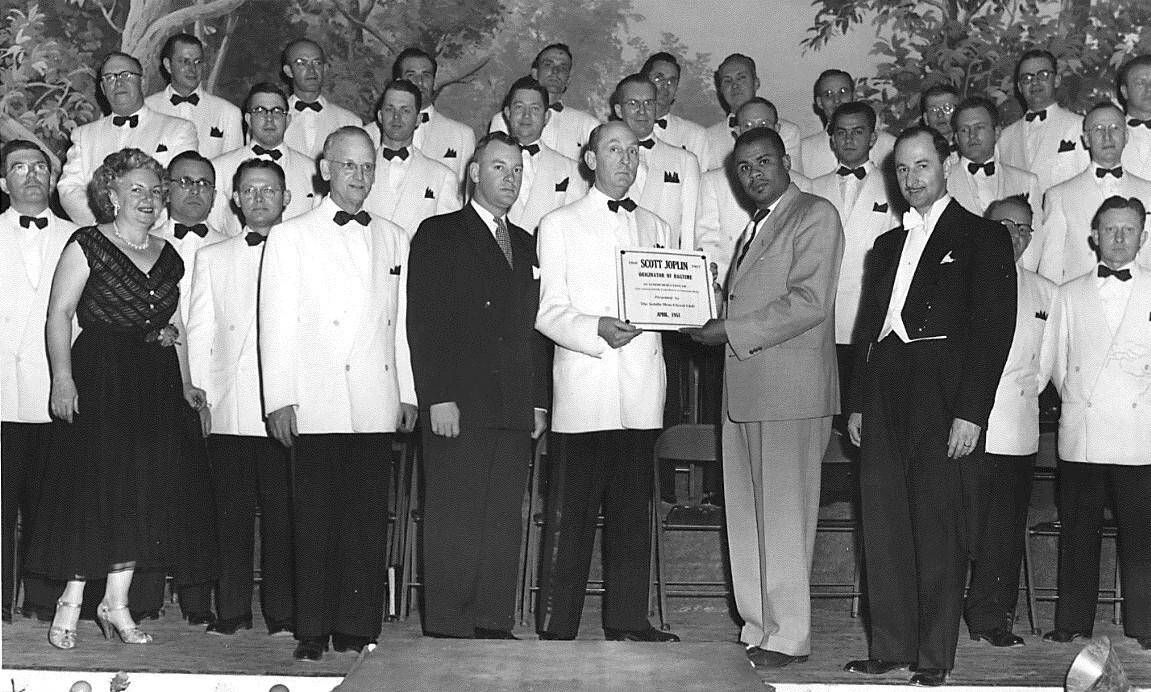Recently, letters written between 1945 and 1951 by S. Brunson Campbell (Scott Joplin’s white pupil in Sedalia in the late 1890s) were made public for the first time. The letters were initially sent to Sedalia newspaper editors. This month I am letting Charles Hanna of Edina, Minnesota, blow the dust from these long-archived letters. But before I describe his 70-year old cache, let me explain how this all came about and then the importance of the letters.
Ever since my interest turned to ragtime in the early 1970s I have been reading about how Brun Campbell lobbied Sedalia to do something in recognition of Scott Joplin and the city’s role as the Cradle of Ragtime. Several of Campbell’s letters were printed in the Sedalia newspapers and ultimately his urging led to the famous 1951 Memorial Concert by the Sedalia Men’s Choral Club and the Memorial plaque placed in the old Lincoln High School Building.
I was specifically intrigued by Campbell’s insistence that Joplin’s “Maple Leaf Rag” was not named for the Sedalia club but for the name of a waltz by that title published by A.W. Perry and Son in 1897. (However, Campbell emphasized that the Maple Leaf Club is where Joplin performed and honed his compositional skills.) Though none of the Joplin biographers or ragtime historians I sincerely respect gave much if any credibility to his story, I still can’t quite let go of it.

Now I can bring my new friend Charles Hanna into this dusty tale. Last month, Hanna wrote to Deb Biermann at the Joplin Festival Office to ask if she would be willing to sell his recently published memoir, Searching for the Sea, in the KATY Depot gift shop. He explained that he had graduated from Smith Cotton high school in 1948 and had been editor of the Sedalia Capital newspaper from 1949-51. (You read that correctly by the way…Charles was the youngest editor of an established daily paper in the country back then at age 19. The Sedalia Capital was the morning edition, the Sedalia Democrat was the evening paper in those days.)
He attached a copy of the section of his book where he described his correspondence with Campbell, Rudi Blesh, and W.C. Handy in the late 1940s and 1950 and how his articles and “Music Modes” column in the Sedalia paper led to the Men’s Choral Club Concert in 1951. He also provided a photograph I had never seen of Z. Lyle Brown and Charles W. Hanna (Charles R. Hanna’s father), presenting the memorial plaque to Principal J. B. Hylick of the Hubbard School.
I was very excited to discover Charles had made contact and emailed him immediately to get acquainted. In that note, I asked if by any chance, he had any of Brun Campbell’s letters. Now I was optimistic, realizing the author must have quite a personal archive of his own to call on, for his memoir is filled with fascinating detail. Hanna graciously offered to look and see what he could find and a few days later he wrote to say he had found some of the Campbell correspondence and he kindly copied the bundle and mailed the duplicates off for my feeble but eager eyes to read.
Now before I describe some of the contents, I must explain that his 70-plus year old letters appeared to be nearly as crisp and neat as the day they were received. He included one short note that was, as many were, written in pencil on an almost tissue-like paper and likewise in pristine condition.
As I was reading from the letters I realized that they had led to all those ragtime articles in the Sedalia papers in the 1940s and 1950s, and that the articles had inspired the 1951 Sedalia Memorial that led to the 1960 Sedalia Centennial Joplin Memorial programs and monument, and that those events led to the 1974 Scott Joplin Ragtime Festival, Joplin stamp ceremony, and subsequent annual festivals relaunched down to the present. (That last sentence reads like the children’s story, “The House that Jack Built.”
When Larry Karp acquired the Brunson Campbell papers after the old ragtimer’s death, Larry went to work sorting the sundry documents, doing meticulous research on the Campbell stories and then writing a marvelously crafted biography, Brun Campbell: The Original Ragtime Kid. That volume was published in 2016. Larry thus had access to the articles that resulted from Campbell’s Sedalia letters. Now much of the other side of that volley of correspondence that helped spur the modern Ragtime Revival is now available.
This whole saga began in 1945 with a long Campbell letter to Rosemary Burrowes, editor of the Sedalia Democrat, urging them to do a story on Joplin and Sedalia as the Cradle of Ragtime. During this period, Campbell was aggressively writing to editors acting as an unofficial publicist for Joplin and Sedalia.
Then a tiny line in a King Features syndicated column the week of March 3-9, 1947, by E.V. Durling in Los Angeles, got Sedalia’s attention when a local resident wrote the editor asking if it was true that ragtime began in their city. In his column, Durling had simply written in response to a question about the origin of the blues, jazz and ragtime, “Ragtime was originated by Scott Joplin in Sedalia, Mo.”
Rosemary Burrowes had already received Campbell’s 1945 letter detailing the Sedalia ragtime story, but she apparently got in touch with Durling to verify Campbell’s information. She must then have written Campbell again because on May 10, 1947, Campbell began the barrage of letters to Rosemary urging her to write an article promoting Joplin and Sedalia. Those letters, all precipitated by Durling’s tiny comment, led to the famous June 29, 1947, Sedalia Democrat article that was picked up by newspapers around the country with the headline “Did you Know Ragtime Music was Born in Sedalia, Missouri?” The same article ran several more times in Sedalia papers including a city centennial edition on October 16, 1960.
Campbell’s letters to Rosemary Burrowes continued, sometimes daily through June 1948. He was presumptuously seeking photographs and information for a book he was writing; he was promoting a memorial for Joplin’s grave; and he even asked Burrowes to type a manuscript for him.
Then in April of 1950 letters from Brun Campbell began crossing Charles Hanna’s desk after Hanna wrote Joplin’s protégée. That letter began a new deluge of correspondence to the youngest editor of a daily newspaper in the country. At some point during this period, Charles’ father Charles W. Hanna became interested in this local ragtime story and as a downtown Sedalia businessman, Charles W. began lobbying for Joplin’s recognition.
There were frustrations for father and son as they began promoting the memorial idea until a family friend picked up the challenge. The energetic local director of the Sedalia Symphony (the second oldest continuously performing symphony west of the Mississippi by the way) and the Men’s Choral Club, Abe Rosenthal, took up the cause.

As an aside, I knew many of Charles Hanna’s acquaintances in Sedalia a generation later. I can testify to Abe’s enormous enthusiasm for promoting music and he worked tirelessly for the community. Abe was the lay Rabbi of the local Temple Beth El and his involvement added a rich ethnic element to a community project in a place not known for its diversity.
S. Brunson Campbell’s campaign, one of them at least, paid off and on April 17, 1951 the Men’s Choral Club presented a Scott Joplin Memorial Concert in the African-American Hubbard high school and donated a plaque to the school honoring Joplin. Charles Hanna’s father, Charles W. Hanna, stood in for his son in the presentation photo because the young editor had joined the Air Force and was in training. Charles, the younger, received high credit from Mayor Herb Studer for his articles encouraging the event and for his help with They All Played Ragtime.
After working on the transcripts, I find some interesting people and places to investigate further. However, I have asked some of the most knowledgeable authorities on Brun Campbell to review the Hanna letters for anything substantially new.
The letters do, however, provide a new acquaintance to one of the more controversial of the original ragtime cast members. There is something about reading someone’s actual handwriting that gives a depth to the words that are lost in edited text. Larry Karp’s great biography addressed many of the flaws in Campbell’s telling of Scott Joplin’s story and he gave us a coherent narrative of Brun’s life. Charles Hanna’s archive affords a new window on that life.
Now some more of what can only be described as a wave in the tsunami of Campbell correspondence that helped spur the Ragtime Revival has been preserved.
The transcripts will be available to the credible inquirers after May 1st. Contact me by email if you would like a digital copy for only the cost of distribution. Indicate CD or travel drive format.
I would have found Charles Hanna’s memoir fascinating even without his Sedalia reminiscence and his stories of covering the jazz scene while in Minneapolis. It is very well written from an active memory nudged by an extensive personal archive.
Searching for the Sea is available through Amazon.com and at the KATY Depot in Sedalia for those attending the Scott Joplin International Ragtime Festival there May 30 to June 2.
Larry Melton was a founder of the Scott Joplin Ragtime Festival in 1974 and the Sedalia Ragtime Archive in 1976. He was a Sedalia Chamber of Commerce manager before moving on to Union, Missouri where he is currently helping to conserve the Ragtime collection of the Sedalia Heritage Foundation. Write him at lcmelton67@gmail.com.






















